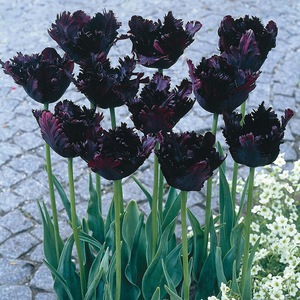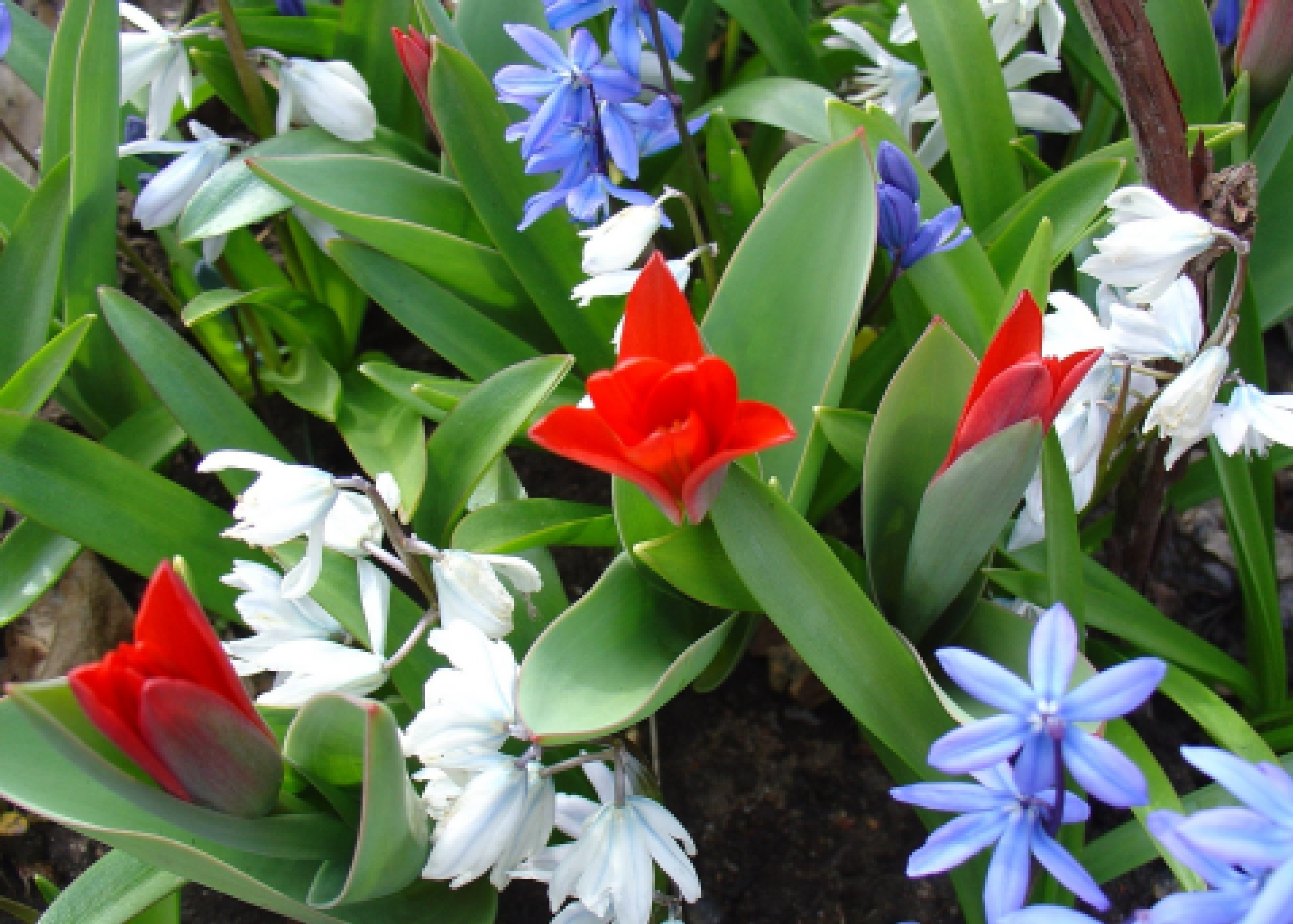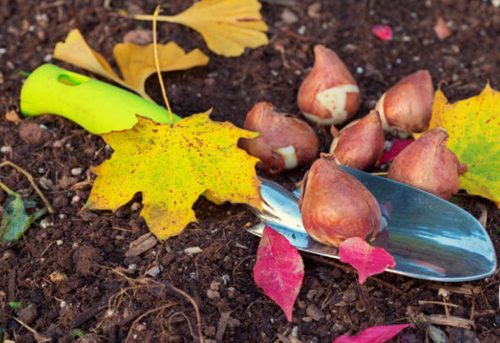The most appropriate time to plant tulips outdoors depends on factors inherent in the local climate and the characteristics of the region. Generally, the best time to transplant or plant tulip bulbs is during the fall. But when asked how to plant tulips and whether it is possible to plant tulips in the ground in spring, the answer is ambiguous for all gardeners. Naturally, planting tulips in spring is possible, but these plants will bloom only next year.
Content
General information on planting
It is naturally possible to plant these plants in a flowerbed or in the soil of flower beds in the spring, but this process will only be an intermediate link. The bushes will be able to bloom normally only after a year. For flowering, you need ripe flower bud near the plant bulb. Planting tulips in spring is not so difficult, but it has its own characteristics and nuances.
If the bulbs are planted in the ground without any pre-planting preparation, they will begin to bloom two weeks later. For planting in early spring, the bulbs must be placed in a box that is half filled with good quality soil. With this option, the sprouts on the bulbs will hatch by the time the tulips need to be planted on open ground.
How do I prepare the bulbs for planting in the spring so they bloom?
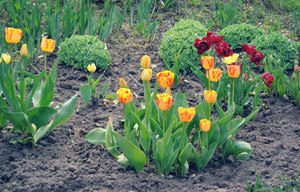 Before planting bulbs in the spring, they certainly need to perform procedures that strengthen their "immunity". To do this, the bulbs, before planting, you need place in a vegetable box at the bottom of the refrigerator, here the temperature readings can be approximately + 4C.
Before planting bulbs in the spring, they certainly need to perform procedures that strengthen their "immunity". To do this, the bulbs, before planting, you need place in a vegetable box at the bottom of the refrigerator, here the temperature readings can be approximately + 4C.
When the hardening of the bulbs is completed, the planting raw materials must be qualitatively protected from possible diseases and pests. For this, the planting material is placed in a slightly pinkish mixture of pharmacy potassium permanganate for half an hour. It must be remembered that the healthiest and strongest tulips can only be grown from quality bulbs.
Before planting bulbs in open field beds in the spring, you need to make an inspection for the integrity of the upper casing layer, as well as the absence of infections with fungal diseases. "Defective" planting raw materials can be the cause of poor flowering and stunted plants.
Also, the pre-planting use of a pharmacy broth of celandine, in which you need to soak the tulip bulbs for half an hour, and then dry it a little at room temperature, has also proven itself excellent.
How and when to plant tulips in spring?
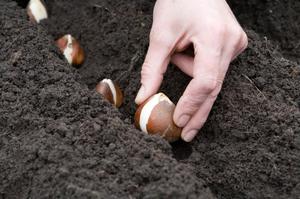 The best type of soil for tulips is considered to be humus-enriched, cultivated type of loam and sandy loam with a neutral indicator. A heavy version of clay soil needs a radical improvement method, which consists in adding coarse river sand with the introduction of manure and peat... The peat that is used must be neutralized by adding lime.
The best type of soil for tulips is considered to be humus-enriched, cultivated type of loam and sandy loam with a neutral indicator. A heavy version of clay soil needs a radical improvement method, which consists in adding coarse river sand with the introduction of manure and peat... The peat that is used must be neutralized by adding lime.
With the onset of spring, and high-quality thawing of the earth, it is necessary to cultivate the soil for replanting or planting tulips. If the ground allows, then its digging must take place to the depth of the shovel bayonet. Then any organic groundbait is added, in addition to fresh manure.
If at the very beginning the fertility of the earth is in doubt, then, in addition to organic fertilizers, various mineral fertilizers must be added. An excellent result is shown by the addition of nitrogen-containing compounds, double superphosphate, and potassium sulfate.
If the land for growing tulips belongs to the "light" class, then the mineral dressing must include small amounts of potassium, phosphorus and nitrogen... If it is necessary to make top dressing in heavy soil, then the basis of the bait must be the same elements, but in much larger quantities.
The best temperature conditions for high-quality rooting of planting raw materials ranges from + 6C to + 11C. If higher or lower temperatures are observed, then the root system of plants is formed much worse. These indicators make it possible to replant or plant planting raw materials when the earth is already warmed up by at least 11C.
Early flowering plant varieties should preferably be replanted or planted a few weeks later than late flowering varieties. The planting depth is most often three sizes of the bulb, and the planting density should not exceed more than 2 of its diameters. Planting material, small in size, can be grown separately from the main planting of plants, and then planted in a permanent place in open ground.
Initial care of planted tulips
Care is necessary even at the stage of tulip sprout formation. At this time, care activities consist in the following actions:
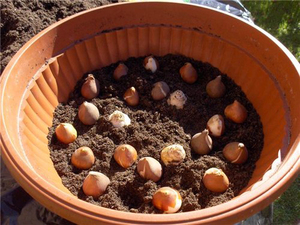 Digging up found "defective" plants with their further destruction in order to prevent the spread of infection to healthy tulips.
Digging up found "defective" plants with their further destruction in order to prevent the spread of infection to healthy tulips.- Conducting a thorough examination to identify bulbs that have not sprouted and to determine if tulips are showing signs of disease.
- Conducting small watering to prevent drying out of the land in flower beds and flower beds.
- Gently loosening the soil near the formed small tulip sprouts to reduce the release of moisture from the ground and increase the availability of the required air to the root system.
- The first dressing of tulips is carried out using nitrogen-containing dressings, which activate the formation of leaves and the rapid growth of the plant. During the care at this stage, it is possible to add "Crystallin" with the addition of tableted microelements or nitroammofosk.
Next top dressing is not considered necessary for tulip care, but the benefits of adding groundbait to plants at this unfolding of the second and third leaf will be significant.
Caring for tulips after flowering
The period when tulips have completely faded, regardless of the cultivar and variety, the plants planted in spring, needs such events:
- Petals that have fallen from the plant must be removed so that they do not start to rot and do not cause the development of diseases and infections.
- To reproduce the species you like and grow healthy and large bulbs for this purpose, it is necessary to cut off the plant heads a week after flowering. This method activates the growth and formation of the mass of the bulb.
- You can use the test digging option to determine the maturity level of a particular tulip cultivar or species.
- On faded plants, the stems should not be cut until the period of complete yellowing, since pruning has a negative effect on the maturation of the bulbs.
When digging out the bulbs, you must be very careful not to accidentally injure the roots of the plant.To complete this activity, it is desirable choose a sunny and dry day... This will make it possible to effectively dry all the dug up bulbs.
Diseases and pests
Proper and timely care of plants makes it possible to obtain high-quality tulip bulbs and flowers, but at the same time, one should not forget about the health of tulips. To do this, you need to learn how to recognize diseases, know how to deal with them and, most importantly, be able to prevent these diseases. Preventive measures include such activities:
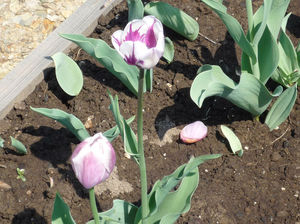 choosing a place where you will plant tulips that meets the requirements of this variety;
choosing a place where you will plant tulips that meets the requirements of this variety;- soil preparation before planting;
- fertilization;
- timely feeding;
- observance of crop rotation - tulips must be grown in one place for no longer than 5 years;
- careful selection and rejection of suspicious and diseased bulbs, planting only healthy planting raw materials;
- compliance with the required depth and density of planting plants;
- timely implementation of care measures, maintaining the cleanliness of the tulip collection and good sanitary condition;
- timely harvesting of bulbs;
- damage to the bulbs is unacceptable;
- use of a disinfected container for storing planting material;
- removal of diseased flowers along with the roots.
Naturally, the above measures do not give a complete guarantee that the plants will not get sick, but the implementation of these measures will make it possible to significantly reduce the likelihood of infection tulips diseases.
Tulips, like all plants, are damaged by various diseases and have many pests. In our country, about 35 bacterial, viral and fungal diseases of these plants are known, but most of them are very rare. The greatest harm to plants is caused by diseases such as fusarium, sclerocial and gray rot.
Tulips are not considered the most whimsical flowers. But they still require care. Flower care should begin with the planting of the bulbs. And it doesn't matter when they are planted, in autumn or spring. Much more important create optimal conditions for the development and growth of the bulb. With careful and proper care, tulips bloom in large buds, delighting with their uniqueness and beauty. The main thing is not to forget that varietal tulips do not differ from wild ones.
